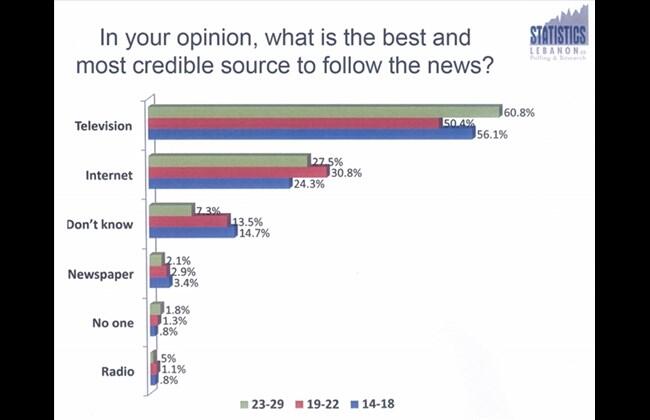TV remains the leading source of news for Lebanon’s youth, but the Internet is now the most used media platform overall among young people, according to a survey commissioned by UNESCO. Respondents registered significantly less interest in traditional forms of mass media, including print and radio. The study, entitled “Survey on the Knowledge and Perception of Youth towards Media in Lebanon,” showed that television remains very popular among youth, and continues to enjoy widespread popularity, despite the rise of online media. The survey was carried out by UNESCO in cooperation with “Statistics Lebanon,” under the framework of the EU-funded Network of Mediterranean Youth Project. The poll targeted 1,200 Lebanese between the ages of 14 and 29, divided equally between men and women. The study also separated respondents into age-based subgroups of 14-18, 19-22, and 23-29, in order to analyze age-specific trends, and posed a range of questions examining the relationship between youth and media in Lebanon. Those surveyed were most likely to call television “the best and most credible source” for news. More than half the respondents in each age group singled it out as such; more than 60 percent of those 23-29 did so. The Internet was ranked next, with newspapers and radio taking the bottom spots. Some 98 percent of respondents said television was a type of media they usually follow. Websites were second with 96 percent, followed by 95 percent for online social media. Though all three were almost universally consumed, the same was not true for radio and newspapers. Only 38 percent said they usually listened to the radio, and just 13 percent said they usually read newspapers. “This is an indication for [the future], that television will remain important,” said Rabih Haber, director of Statistics Lebanon. “However, the [area] of biggest importance will continue to be in websites and online media. We spoke with the young generation, and this will continue in the future, [while] newspapers and radio will become less important.” Television has widespread appeal, especially its entertainment programming. Some 78 percent of respondents said they “usually followed” broadcasts of foreign films; local entertainment was right behind with 77 percent, and news third with 72. Only 41 percent said they usually followed political programs. “This also means that there’s no loyalty to local TV stations. Everyone is heading to foreign [channels] that broadcast movies continuously,” Haber said. An interesting fact gleaned from the survey is that almost everyone polled said they had Internet access. Some 95 percent said they were subscribed to an Internet service of some type, and nearly all said they used it to access social networking sites. According to the survey, mobile phones are the most widely used devices for going online, with 96 percent of respondents saying they used them to access the Internet. Laptops were next with 67 percent; just 11 percent said they used a desktop computer to go online. Though laptops continue to be popular in general, they tend to be used for different purposes than phones, with respondents preferring them for work, study and research. Print media and radio also seem to be used for more specialized consumption of content. The survey found that 95 percent of the respondents use the radio to listen to music, while just 39 percent use the radio to follow news. Those surveyed were least interested in hearing artist interviews, religious programming and political interviews. “I think people are running away from politics,” Haber said. Print was the least followed media overall. Perhaps unsurprisingly, those who said they usually followed the newspapers were particularly interested in the news coverage itself rather than other content. Some 83 percent said they read newspapers to follow world news, and 79 percent to follow local political developments. Ghinwa Obeid| The Daily Star












